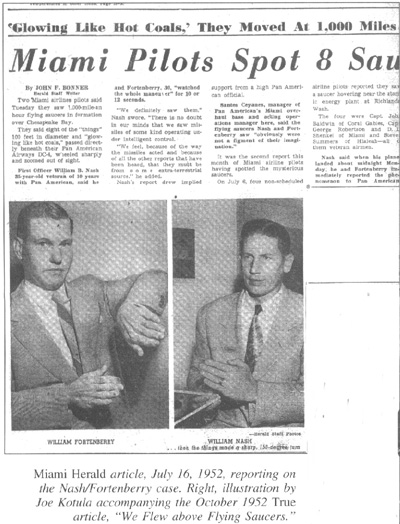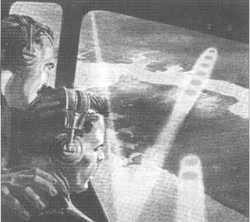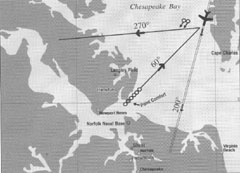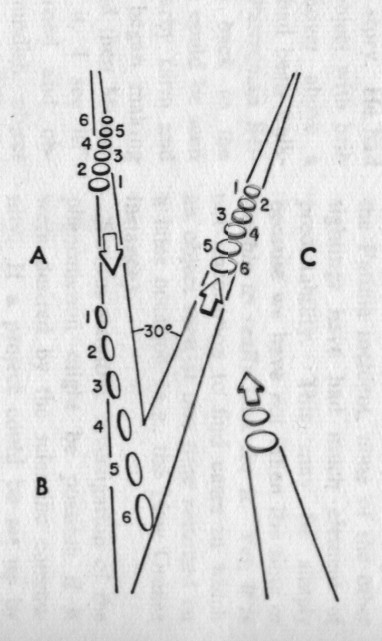The 1952 Nash/Fortenberry Sighting by Tom Tulien
On the evening of July 14,1952, a Pan American World Airways DC-4 was on a routine flight, ferrying from New York to Miami with ten passengers and a crew of three, including, Captain F. V. Koepke, First Officer William B. Nash and Second Officer William H. Fortenberry. The sun had set an hour before though the coastline was still visible, and the night was clear and almost entirely dark. With the aircraft set on automatic pilot, while cruising at 8000 feet over the Chesapeake Bay approaching Norfolk, Virginia, they were due to over fly the VRF radio range station in six minutes and make a position report. In the mean time, since this was Fortenberry’s first run on this course, Nash, in the left pilot’s seat, was orientating Fortenberry by pointing out landmarks and the distant lights of the cities along the route. Nash had just pointed out the city of Newport News and Cumberland, ahead and to the right of the plane, when unexpectedly a red-orange brilliance appeared near the ground, beyond and slightly east of Newport News. The brilliance seemed to have appeared all of a sudden and both pilots witnessed the startling appearance at practically the same moment. In the excitement someone blurted out, “What the hell is that?” Captain Nash later described their initial observations…
What occurred next utterly astonished the pilots. The procession shot forward
like a stream of tracer bullets, out over the Chesapeake Bay to within a half-mile
of the plane. Realizing that the line was going to pass under the nose of
the plane and to the right of the copilot, Nash quickly unfastened his seat
belt so that he could move to the window on that side. During this interval,
Nash briefly lost sight of the objects, though Fortenberry kept them in view
below the plane and both would later recollect…
This shift had taken only a brief second and was completed by the time Nash reached the window. Both pilots then observed the discs flip back from on-edge to the flat position and the entire line dart off to the West in a direction that formed a sharp angle with their initial course, holding the new formation. The pilots had noticed that the objects seemed to dim slightly just prior to the abrupt angular turn and had brightened considerably after making it. Attempting to describe the objects extreme actions, Nash proposed, “The only descriptive comparison we can offer is a ball ricocheting off a wall.” An instant later, two more identical objects darted out past the right
wing, from behind and under the airplane at the same altitude as the others
and quickly fell in behind the receding procession. They observed that these
two seemed to glow considerably brighter than the others, as though applying
power to catch up. As they stared after them dumbfounded, suddenly the lights
of all of the objects blinked out, only to reappear a moment later, maintaining
low altitude out across the blackness of the bay, until about 10 miles beyond
Newport News when they began climbing in a graceful arc that carried them
well above the plane’s altitude. Sweeping upward they randomly blinked out
and finally vanished in the dark night sky. Describing the disappearance of
the objects some years later, Nash wrote,
Their bewildered initial reaction is best affirmed in the words of Nash…
The time was 8:12 Eastern Standard Time. As the reality of their experience dawned on them the first question which came to mind was whether anybody else onboard had seen the spectacle. Fortenberry went through the small forward passenger compartment, where the captain was intent on paper work. In the main cabin a cautious inquiry whether anyone had seen anything unusual produced no results. Back in the cockpit, the pilots radioed Norfolk and gave their position according to schedule, and upon receiving confirmation added a second message to be forwarded to the military: "Two pilots of this flight observed eight unidentified objects vicinity Langley Field; estimate speed in excess of 1,000 mph; altitude estimated 2,000 feet." At this point, Captain Koepke came forward and took over control of the DC-4 while Nash and Fortenberry went to work reconstructing the sighting. With a Dalton Mark 7 computer they determined the objects' angle of approach and the same for the angle of departure. The difference between the two was about 30 degrees; therefore, the objects had made a 150-degree change of course almost instantaneously. They were able to accurately determine their position visually and by reference to their position to the VHF range at Norfolk. The objects first appeared beyond and to the east of Newport News and came toward the DC-4 in a straight line, changed direction beneath the plane and departed in a straight line to the West once again passing a suburban edge of Newport News and seemed to travel out over a dark area before they began to climb steeply into the night sky. They determined that Newport News was 25 miles away and added the additional 10 and 30 miles that they estimated the objects had traveled in each direction, arriving at a total distance of 90 miles. To be conservative they decided to use 50 miles, since they had seen them travel at least that distance. Determining the time duration of the sighting was not so straightforward. Wanting to be accurate, they reenacted the exact sequence of events seven times, and using the panel stopwatch clocks determined that the time period did not exceed 12 seconds each time. Again, to be conservative they adopted 15 seconds in the final computation, which meant that the objects were flying at the rate of 200 miles per minute, or 12,000 miles per hour! They estimated that the objects were slightly more than a mile below the
plane, or about 2000 feet above ground level, and by mentally comparing their
appearance with the wingspread of a DC-3 at that distance, judged the size
to be approximately 100 feet diameter and 15 feet thick. Determinations
of distance, size and speed are always open to question by the fact that the
objects observed were unidentified phenomena. However, this particular incident
was especially unique in the sense that the pilots observed the objects between
the ground and the plane. Most sightings occur against an empty sky
without any standard of comparison to known objects or distance, but in this
case the planes altitude of 8000 feet established a finite distance for reference.
Nash later qualified his ability to estimate the altitude of the objects in
a letter to astrophysicist, Dr. Donald H. Menzel.
Further, both Nash and Fortenberry had served in the Navy during the war in which Nash flew patrol bombers for the Naval Air Transport Service patrolling between the African and South American coastlines in search of German submarines. Fortenberry served in the U.S. Navy Air experimental wing for two years and was well aware of aeronautical developments for the time. In naval training, both pilots had received intensive instruction in aircraft identification and had learned to identify every ship in the German Navy. While Nash and Fortenberry were still discussing the matter, the lights of a northbound airliner came into view on a course about 1,000 feet above. Ordinarily the head-on approach of two airliners at 500 mph seems fairly rapid. But in this instance, compared to the streaking speed of the discs, the oncoming plane seemed to be standing still. If any normal happening could have increased the effect of the night's experience, it was just such a commonplace event. They landed at Miami International Airport shortly after midnight. Upon entering the operations office, they found a copy of the message they had transmitted to the military through Norfolk, with an addition: "Advise crew five jets were in area at the time." This didn't exactly apply since the things they had seen were eight in number, and they were dead sure they were not jets. At 7 A.M. Air Force investigators telephoned and an appointment was set for an interview later that morning. USAF Wing Intelligence officer Major John H. Sharpe and four officers from the 7th District Office of Special Investigations met Nash and Fortenberry at the airport. In separate rooms, the pilots were questioned for one hour and forty-five minutes and following that, for a half-hour together. The pilots were duly impressed by the skill and thoroughness of their interrogators. Questions had been prepared in advance and posed individually to the two pilots in order to evaluate their recall. Map overlays were compared and they had a complete weather report for the area, which coincided with the previous night’s flight plan. It stated; 3/8 Cirrus clouds about 20,000 feet. No inversion and a sharply clear night, probably unstable air. Visibility was unusually good. Following the interview, the investigators advised the pilots that they had already received seven additional reports from persons who had witnessed similar incidents within 30 minutes, in the same area. The best was from a Lt. Commander and his wife who described a formation of red discs traveling at high-speed and making immediate directional changes without a turning radius. Being told that their particular experience was by no means unique surprised the pilots. None of these reports appear in the official Blue Book files, though three
reports requested by ATIC in August describe multiple objects cavorting over
Washington D.C. at 9:00 A.M., the morning of the sighting. Fortunately, NICAP
retained copies of some of the confirmatory reports for the evening of July
14, which were published in the Norfolk newspapers. Although none of the reported
sightings appear to describe the identical maneuvers that the pilots witnessed,
a couple are sufficiently similar to be taken as reasonable substantiations.
For example, one witness stated that,
In a letter to the editor of the Norfolk Virginian-Pilot, the naval officer from the cruiser Roanoke, apparently mentioned to Nash and Fortenberry during the OSI investigation, reported that he had sighted eight red lights in the direction of Point Comfort that proceeded in a straight line and then disappeared. He saw the objects at about 8:55 P.M. Eastern Daylight-Saving Time, approximately 15 minutes before the pilot’s sighting, as he was driving towards the Naval base for a 9:00 P.M. appointment. Especially interesting is that as a result of the press coverage of the
Pan American pilots sighting the following day, Paul R. Hill, an aerodynamicist
at the NASA-Langley facility, decided to watch the sky for UFOs on the evening
of July 16. Expecting “conformance to pattern” he parked at the waterfront
a little before 8:00 P.M. and soon observed two amber-colored objects approach
from the South and turn West taking them directly overhead. At this point,
the objects curiously appeared to be alternatively jumping forward of each
other slightly. Then after passing zenith, they made an astounding maneuver.
They began to revolve around a common center, and after a few revolutions,
switched to the vertical plane! Within a few more seconds two more similar
objects joined the first two before all four headed south. Hill later wrote,
This sighting prompted Paul Hill to a life-long study collecting and analyzing sightings’ reports for physical properties and propulsion possibilities in an attempt to make technological sense of the unconventional objects. The study was eventually published posthumously, under the title, Unconventional Flying Objects: A Scientific Analysis (Hampton Roads, 1995), in which Hill presents his thesis that UFOs “obey, not defy, the laws of physics.” At the time of these sightings flying saucers had been big news for many weeks and the staff of nine at Project Blue Book were swamped with sighting reports, far more than they could properly deal with. By mid-July they were getting about twenty reports a day and frantic calls from intelligence officers at every Air Force base in the U.S. The reports they were getting were good ones and could not be easily explained. In fact, the unexplained sightings were running at about 40 percent. All this was leading inexorably to the following weekend when UFOs were picked up by radar at Washington National Airport in restricted air space over the nation’s capitol, and would become one of the most highly publicized sightings of UFO history. For those reasons, the Nash/Fortenberry sighting received a less than adequate investigation. Project Blue Book quickly determined that the five jets flying out of Langley, AFB could not have possibly been responsible for the sighting, and the case was dropped and filed as an “Unknown.” It was not until 1962 that the case would be reexamined by the Director of the Harvard College Observatory, astrophysicist Donald H. Menzel, and published in his book, The World of Flying Saucers: A Scientific Examination of a Major Myth of the Space Age (Doubleday, 1963). At the time, Professor Charles A. Maney, a physicist at Defiance College, had been engaged in a rather lengthy correspondence with Menzel, and when the Nash/Fortenberry sighting came up, Maney forwarded copies of the correspondence to Nash, then an advisor to NICAP. This led to a series of lengthy correspondences over a six-month period between Nash and Menzel providing considerable insight into the process by which Menzel arrived at his eventual solution to the inexplicable sighting. Based on the meager data contained in the official report, Menzel assumed
that the sighting could be reasonably explained as a reflection in the cockpit
windows, especially considering the nearly instantaneous reversal, which seems
to defy the laws of physics pertaining to inertia. In support of this explanation
he underscored the apparent failure of the crew and Air Force investigators
to make any tests for possible reflections, and generally called into question
the credibility of the pilots. In a fairly scathing letter, Nash remonstrated
Menzel on this critical point:
Dr. Menzel’s next line of inquiry concerned whether the reflection could have been caused by an illumination within the cockpit, or possibly a “hostess taking a drag of a cigarette.” Dr. Maney’s rather sardonic response to this possibility was, “Quite a long drag, wouldn’t you say?” But, nevertheless, the pilots weren’t smoking, the cockpit door was closed, there were no hostesses on the flight and the pilot’s observed the object’s reversal out of the right window below the plane. This pretty well convinced Menzel that an internal reflection was unlikely to explain the phenomenon and what Captain Nash had seen was something outside the plane. Still, Menzel concluded that Nash’s observations “… are completely consistent with the theory that the discs were immaterial images made of light.” Therefore, to explain the sighting he theorized that,
The soundness of his theory depended on the prevailing weather conditions.
Since the official weather reports for that evening indicated that there were
no temperature inversions present, Dr. Menzel carefully constructed a scenario
in which inversions (albeit in meteorological parlance, a sub refractive condition)
could have been present though undetectable by the weather service.
Dr. Menzel admitted that his solution does not identify the particular beacon or searchlight responsible for the sightings, though he suggests that, “A light on the Virginia coast, shining northeast toward the plane, could easily have been spread out into a series of images like those observed.” Apparently, the location of the light is assumed to be at the point of the pilot’s initial sighting of the red-glow, beyond and to the East of Newport News. This begs the question why experienced pilots could not identify an apparently fixed high-intensity (red!) light source if it were emanating from a position 25 miles in front and below and directed toward their aircraft. Since the discs were organized in a stepped-up echelon, with the leading disc at the lowest point, one would deduce that the source of the light must have been from behind the aircraft. Had the light source been in front of the aircraft, as Dr. Menzel postulates, the leading disc would have appeared in the highest position in the echelon. Further, a searchlight reflecting off a horizontal cloud layer at an oblique angle to the observer would produce a gradual elongation of the disc as it moves relative to the observer. Nor does the theory account for the two discs that darted out from under the plane and conjoined the original six before disappearing into the night sky. Or the mechanism that would need to be in effect to make the discs appear to flip vertically on edge, reverse position in formation while maintaining relative distances, and then flip back to the horizontal plane (while executing a 150-degree course change at, well, in the words of investigating officer, Major John Sharpe, “…a speed fantastic to contemplate.” Incidentally, 90 miles in 12 seconds equals 27,000 mph!) In his book, Dr. Menzel asserts that his solution offers, “a highly probable explanation that is consistent with all observations and does not depend on the presence of an extraterrestrial spacecraft.” I have to agree with the later part of the statement, but have no doubt that readers will find further inconsistencies in Dr. Menzel’s impracticable solution. Some years later, in early 1957, Bill Fortenberry was lost in a Boeing B-377 Stratocruiser crash in the Pacific Ocean, with all onboard. In the early sixties, Captain Nash transferred to Germany, and for the next 15 years flew the Berlin corridors before retiring from Pan American. In a recent interview for the Sign Oral History Project, a still vivacious Captain Nash provided their concluding supposition…
_______________________________________________________________________
Nash, William B. and Fortenberry, William H. “We Flew Above Flying Saucers.” True Magazine, October 1952: p. 65, 110-112. Ruppelt, Edward J. Report on Unidentified Flying Objects. Doubleday and Company, Garden City, NY, 1956. Menzel, Donald H. The World of Flying Saucers: A Scientific Examination of a Major Myth of the Space Age. Doubleday and Company, Garden City, NY, 1965. Hill, Paul R. Unconventional Flying Objects: A Scientific Analysis. Hampton Roads, Charlottesville, VA, 1995. USAF Project Blue Book files, National Archives and Records Administration, Washington D.C. Personal files of William B. Nash. (Copies of the Nash files with the Sign Historical Group). “Rockets, Tracers or Them Devilish Flying Saucers,” Norfolk Virginian-Pilot, July 17, 1952. The Witness: “A Precise Report on Flying Saucers—Or Something,” Norfolk Virginian-Pilot, July 20, 1952, p. 6. Nash, William B., 2002. Interviewed by Thomas Tulien and Jan Aldrich, January
4, (Sign Oral History Project). |
||||||||||||
NICAP Home Page |
 .........
.........


